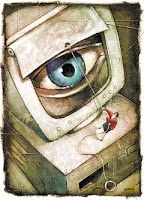
I got a really interesting reference question last week about a California Proposition 65 warning on a water heater. A woman called the reference desk (you can call, too, anytime we’re open at 974-7400, option #3) and told me she found in her new water heater’s use and care manual a Proposition 65 warning reading:
“California Proposition 65: Warning: This product contains chemicals known to the State of California to cause cancer, birth defects or other reproductive harm.”
She wanted to know what this warning meant – specifically, which chemicals were in her water heater, so she could research them fully. I had never heard of Proposition 65, so I had no idea what to tell her or where exactly that information could be found. I took down the model number of the water heater and her phone number so I could call her back after I did a bit of research.
I first wanted to have some understanding of what Proposition 65 actually was. Essentially, it’s a
21-page list of chemicals the Governor of California is required to maintain and re-publish at least yearly. Any amount of any of these chemicals found in household products or industrial appliances require a business to put a Prop. 65 warning on it.
With that understanding out of the way, I went on to try to figure out which chemicals happened to be in this particular product only to be thwarted by
this statement on the
California Office of Environmental Health Hazard Assessment’s (OEHHA) website that basically reads that businesses are not required to report why a Prop. 65 warning has been added to a product.
Unfortunately, I wasn’t going to find this information that easily and I had to refer the customer back to the company that manufactured the water heater. She had mentioned this not being successful in a previous attempt, so I utilized the always helpful
ReferenceUSA (requires an APL library card to access from home) to get her the telephone number for the corporate headquarters rather than the customer service 800 number.
I was surprised the information this customer sought was not publicly available and easy to find, especially considering how much info has been released over the past years about chemicals linked to, as Prop. 65 states, “cancer, birth defects, and other reproductive harm”. Just yesterday, a press release was put out by the
Environmental Working Group (EWG) announcing the
President’s Cancer Panel report on Americans’ exposure to chemicals found in the environment, household products, cosmetics, and foods. The report indicates that the incidence of some cancers is on the rise for “unexplained reasons” (in fact, 41% of Americans will be diagnosed with cancer) and it is believed by many scientists that this rise is linked to the rise of chemicals used in our day-to-day products and environments, many of which have been linked to hazardous effects on human health.
While it seems virtually impossible to avoid harmful chemicals altogether, the resources below found on the internet and provided by the library can help you make better decisions about the products you are purchasing or may already have in your home. Not to mention the knowledgeable reference
librarians just a click or phone call away ready to provide you with helpful, quality information!
The EWG provides several great resources. I used the below links (plus what is linked to within the above paragraphs) to help write this blog post:
Cosmetics DatabaseThe cosmetics industry is largely un-regulated (for a good article on this
click here), so no company is held accountable for the ingredients they put in their products. This database can help you determine the level of risk associated with using certain cosmetics.
Health TipsHousehold Products DatabaseUS Dept of Health and Human Services database that provides “health and safety information on household products”
Reducing Environmental Cancer RiskThe full report of the President’s Cancer Panel just released April 2010.
Shopper’s Guide on avoiding produce high in pesticide residues
According to research, by avoiding the “Dirty Dozen” (or, making sure to buy organic the foods on this list) and sticking to the “Clean 15”, you can reduce your pesticide consumption by four-fifths. Pesticides have been shown to cause many types of health problems in humans (for example, see
Health Problems Pesticides May Pose by the
EPA and
Pesticides and Food, a research guide created by the
Library of Congress)
Tap Water DatabaseFind out more about how your local water supply ranks and a
guide to choosing a good water filter.
ToxRefDB: Toxicity Reference DatabaseA new database provided by the EPA - you can search chemicals by name to find out more about any effects they may be known to have on human health.
ARTICLES:
Panel Sounds Alarm on Environmental Cancer RisksFrom
CBS NewsUS Facing ‘Grievous Harm’ in Air, Food, Water, Panel SaysFrom
The Washington PostPresident’s Cancer Panel Calls for Fundamental Shift in Chemicals PolicyFrom
PR NewswireBOOKS:
The Body Toxic: How the Hazardous Chemistry of Everyday Things Threatens Our Health and Well-BeingDangerous or Safe?: Which Foods, Medicines, and Chemicals Really Put Your Kids at RiskDoubt is Their Product: How Industry's Assault on Science Threatens Your HealthThe Green Beauty Guide: Your Essential Resource to Organic and Natural Skin Care, Hair Care, Makeup, and FragrancesHow Everyday Products Make People Sick: Toxins at Home and in the WorkplaceNot Just A Pretty Face: The Ugly Side of the Beauty Industry


















